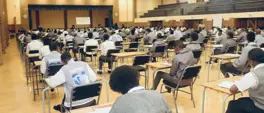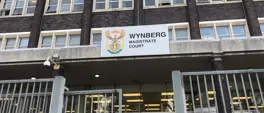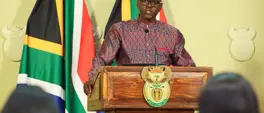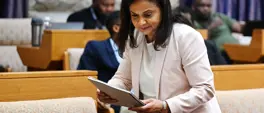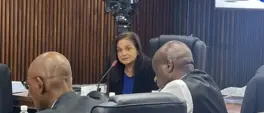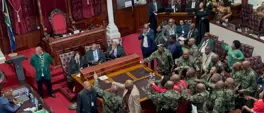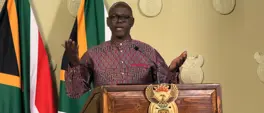LEBOGANG RAMAFOKO: Women and civil society must play a bigger role in the Just Energy Transition
Lebogang Ramafoko
26 August 2024 | 12:40Energy inequalities are not only geographic and racialised, but also gendered, and women should have a role in processes that impact their ability to carry out essential social reproduction and care duties, writes Lebogang Ramafoko.
In 2021, the South African government announced the adoption of the Just Energy Transition Partnership (JETP) with France, Germany, the United States and the United Kingdom.
The Just Energy Transition (JET) focuses on the transition of South Africa’s energy sector as the country navigates the shift away from coal towards cleaner sources of energy.
The Presidential Climate Commission, an independent, multi-stakeholder body, is tasked with overseeing and facilitating a just and equitable transition towards a low-emissions and climate-resilient economy. Chaired by President Cyril Ramaphosa, it comprises government ministers and 22 commissioners that represent diverse perspectives and sectors including academia, the private sector and civil society.
The establishment of the Commission came at a time when the power utility Eskom was experiencing severe financial and governance challenges that led to unprecedented power cuts, which have crippled the national and regional economy.
The introduction of the Energy Action Plan in 2022, and the subsequent adoption of the Generation Recovery Plan the following year, have seen an improvement in electricity supply in the country. The recent passing of the Electricity Regulation Amendment (ERA) Bill, aimed at enabling the establishment of an open market platform for electricity trading, have all been welcome developments in the quest to stabilise the country’s energy supply.
And while these interventions are welcome, important questions must be asked about the extent to which women are involved in energy policy development and related processes.
STEPS TAKEN, BUT SIDELINING REMAINS
The government has taken steps to ensure greater women participation in the energy sector.
In 2021, the Women Empowerment and Gender Equality (WEDE) Strategy was launched to facilitate more active involvement of women in South Africa’s energy sector. This policy acknowledges the historical exclusion of women from the sector, and represents the government's commitment to rectify this exclusion through concerted efforts.
Despite this, empirical evidence suggests that women continue to be hurled at the margins in policy-making processes, and that communities most affected by power cuts and the energy transition are being left out of both the decisions and the value chain of transition efforts.
Oxfam South Africa, in partnership with Oxfam America, recently published a research report that places women and girls at the centre of the JET. The report, titled The gendered energy crisis: Prospects for an eco-feminist Just Energy Transition in South Africa, employs an ecofeminist approach to the problem of energy poverty. It reviews existing policy to identify mechanisms for the public to hold the government, Eskom, and the private sector accountable for socially just outcomes of the planned energy transition.
Significantly, the report provides an overview of some of the outcomes of renewable energy projects to date, drawing on empirical studies on the actual effects on communities, households, women and girls.
The energy crisis in South Africa has its roots in the Minerals-Energy Complex (MEC) – a system of accumulation that had a determining retarding effect on the country’s industrialisation.
The establishment of Eskom in 1923 was an instrument aimed at sustaining the MEC through the provision of cheap electricity for the mining sector and railways. It also includes the provision of electricity for agriculture, which would become the backbone for the apartheid economy that was both racialised and gendered.
Thus, from inception, Eskom’s key priority was to support the industrial and agricultural economy. Later, the provision of electricity would extend to commercial activities and households of the white minority, to the exclusion of households and communities of the indigenous population.
While the post-apartheid dispensation has seen the expansion of electricity provision to more than 90% of South African households, problems relating to the mismanagement and poor governance of Eskom, the power utility’s ballooning debt, ageing energy infrastructure and corruption in the supply chain processes of Eskom have led to the persistent problem of power cuts (euphemistically called load shedding), that have had a devastating impact on the national and regional economy.
And while more South Africans have access to electricity today than they did in 1994, numbers do not tell the complete story.
In the Oxfam research report, the ongoing crisis of energy insecurity, which mainly affects low-income households and communities, both urban and rural, is explored.
One of the key findings of the study is that access to electricity does not guarantee energy security. This is largely due to the soaring costs of electricity, which are unaffordable to millions of South Africans. This has forced many households to continue using harmful energy sources.
As of 2022, nearly half of all households in South Africa are headed by women. Most of the households headed by women are in provinces with larger proportions of rural areas, such as the Eastern Cape and Limpopo.
This indicates that energy inequalities are not only geographic and racialised, but also gendered. This is corroborates the findings of the report titled Energy Racism: The Electricity Crisis in South Africa, published by the Center for Sociological Research and Practice at the University of Johannesburg, which found that townships, which are predominantly black, had the most hours of power cuts over the 30-day period in which data was taken in the province of Gauteng.
This continuation of the legacy of apartheid and separate development, characterised by limiting access to electricity to low-income black communities, illustrates the core arguments in the Oxfam report about the inequities of energy security which, if not adequately addressed, could see the JET follow along the same path.
Women should have a role in processes that impact their ability to carry out essential social reproduction and care duties, which underpin both the productive economy and the replenishment of the workforce.
Hence, an essential step towards addressing these challenges is increasing citizen involvement in the energy system and transition
Currently, it is not clear to what extent local communities benefit from the current rollout of extensive renewable energy plants, such as whether energy is provided more cheaply, or whether cleaner sources of energy are available to the communities where the energy is being produced.
Research conducted by Malope in Loeriesfontein, located in South Africa’s Northern Cape province, reveals that the current approach to community development within the Renewable Energy Independent Power Producer Procurement Programme (REIPPPP) is “top-down”, with minimal community involvement in decision-making processes related to power projects.
Empirical research indicates that the specific needs of households are often overlooked. Although community development plans are supposed to be a key element of a company’s success in securing an Independent Power Producer (IPP) bid, and theoretically offer significant opportunities for social and local development, in practice, these plans are not made publicly available even after the bid winners are announced.
Consequently, the anticipated social development is not felt by local community members. In the current top-down model of the REIPPPP, IPPs propose community projects, which are then managed and monitored by their local teams. These projects are typically once-off initiatives in specific sectors.
PRIORITISE HOUSEHOLDS AND WOMEN
Oxfam advocates for an alternative approach that prioritises the household, recognising its critical role in social reproduction.
The eco-feminist perspective presented in the Oxfam report underscores the severe effects of energy poverty, and its disproportionate impact on working-class communities, women, and girls.
It emphasises the necessity for civil society vigilance and the effective utilisation of existing laws and progressive policies to realise human development and gender equity outcomes. This will require enhanced participation by communities in the REIPPPP, which is currently dominated by bids from Global North countries such as Germany, Spain, France and Italy.
Community engagement must be at the heart of the JET. The role of civil society organisations is central to this redress.
It is crucial that community workshops and focus groups are conducted with caregivers to understand their energy needs and challenges and use these insights to shape advocacy efforts.
Furthermore, communities must be educated about the links between energy access, the care economy, and social reproduction, highlighting the importance of sustainable energy for caregiving.
Additionally, existing policies should be leveraged for accountability, ensuring the fair representation of women. Funding must also be used to support gender and climate mainstreaming initiatives.
These and other recommendations are contained in the Oxfam report, the ultimate objective of which is to address energy poverty in a way that supports the care economy and social reproduction, while promoting gender equality and empowering women in South Africa.
Lebogang Ramafoko is the Executive Director of Oxfam South Africa.
Get the whole picture 💡
Take a look at the topic timeline for all related articles.
Trending News
More in Opinion
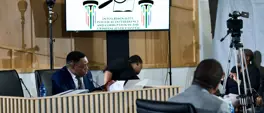
12 December 2025 15:34
CHARLES MATSEKE | The Republic of commissions arrives at its point of no return

12 December 2025 14:15
REBONE TAU | Ekurhuleni needs bold, decisive leaders to reverse years of capture

12 December 2025 05:13
MANDY WIENER | Searching for a superhero with a spine of steel: Why the position of NDPP matters so much



